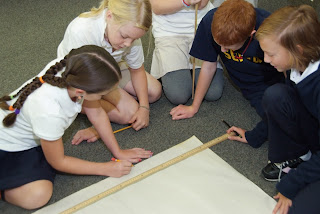
I believe that almost all students enter school full of joy and excitement. The thrill of engaging in novel activities, the anticipation of learning new things, and the satisfaction that comes with mastery, all make children look forward to coming to school. However, if we do not actively nurture that joy – if we stifle it with uninspired, developmentally inappropriate programming and curriculum – we actually encourage children to disengage from the learning process. It is very difficult to recapture the interest of a student who has decided that school is not worthwhile.
It is particularly important at the preschool and early elementary levels of education to provide a learning environment that is engaging and developmentally responsive. This is children’s first experience with school and will solidify for years to come their concepts of themselves as learners. If they learn that school is an interesting place where they can be challenged and successful, they will carry that feeling forward into the upper grades. Alternatively, if children learn in their early years that school is dull, or too difficult, or unfair, then these are the feelings they will carry forward. Thus, the early years of schooling provide the foundation, not only academically, but social-emotionally, for the rest of a student’s life. Early childhood educators must take on this responsibility with deep thought and respect.
It seems to me that many lifelong learning skills are best taught to young children, so that they have the maximum amount of time to understand them, practice them, and integrate them into their concepts of themselves in the world. I see little sense in waiting to introduce higher order thinking skills later in life, after patterns of thought and behavior have been well established. If we expect our high school and college students to be critical thinkers – able to apply, analyze, synthesize and evaluate new information – then we must help them to begin developing these skills early on. If elementary school children learn only by rote memory, call and response, and artificial application of facts, they will have difficulty learning to think critically and independently as older students.
I experienced this phenomenon when I taught international high school students. Many students who had grown up in traditional educational systems were frustrated when I asked them to analyze situations critically, or to develop their own personal voices. One student even exclaimed, “Just tell me what you want me to say.” He was frustrated because he had not developed the confidence and thinking skills necessary to formulate and express his own original ideas. Who could blame him?
Problem solving and
interpersonal relationships are also skills our children need to begin learning at an early age, because their successes or failures in these areas will build upon themselves over the years. In addition, students need basic “core knowledge” upon which to layer further learning. We know from the brain-based research how long-term memory and understandings are created; it is not through repetitive worksheets and meaningless homework. We all learn most deeply when we connect new information to our past knowledge, and when we can personally interact with information. This means we remember a story or passage in a book much better when we have to retell it, or act it out, or draw an interpretive picture of it, than when we just read it. The same holds true, of course, with concepts in math, science, social studies, and other subjects. Most children learn to add, subtract, multiply and divide. But do they really understand the mathematical interactions that are going on? Can they apply those skills in a variety of authentic, real-life situations, or only with pencil and paper in a classroom exercise?
These are the things we talk about and focus on in our school. We know that in our quest to produce lifelong learners, we must instill in our youngest students a deep sense of competency, curiosity, and enthusiasm for learning that they will carry with them into future learning environments.
Learn more about Seneca Academy at
www.SenecaAcademy.org
Seneca Academy
15601 Germantown Road
Darnestown, Maryland 20874
Phone: (301) 869-3728
Fax: (301) 869-3348






